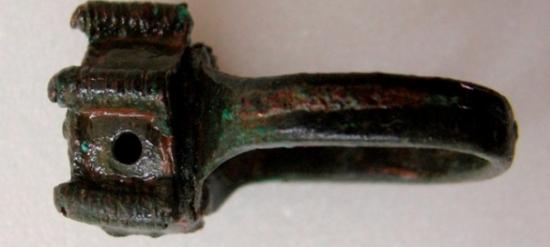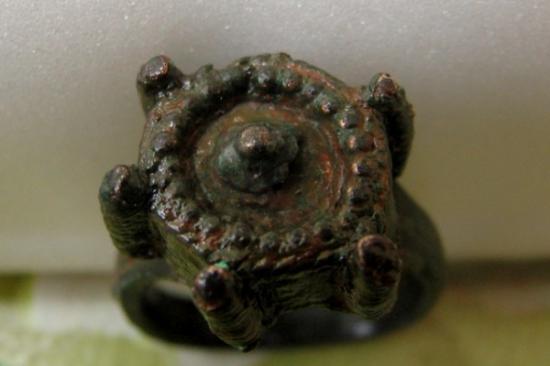Photos via Kavarna Municipality
Source - http://sofiaglobe.com/2013/08/20/14th-century-poison-ring-found-near-bulgarias-kavarna/

Bulgarian archaeologists working on the remains of the medieval fortress on Cape Kaliakra, near the town of Kavarna on the Bulgarian Black Sea coast, have found a well-preserved poison ring, Kavarna city hall said on August 20.
The find is the first of its kind not just at Kaliakra, but anywhere in Bulgaria, the head of the dig, Boni Petrunova, the deputy director of the National Archaeology Institute and Museum in Sofia, said.
Made of bronze, the ring has a small box welded to the bezel and was meant for a male, most likely worn on the little finger, Petrunova said.
The ring was a stand-alone find in the inner city on Cape Kaliakra, in an area that housed the local aristocracy – since 2011, more than 30 items of jewellery, made of gold, have been found there, she said.
“I have no doubts that the hole is there on purpose and the ring was worn on the right hand, because the hole was made in such a way so as to be covered by a finger, so that the poison can be dropped at a moment’s notice. Clearly, it was not worn constantly and would have been put on when necessary,” Petrunova said.
The find is direct proof that poison was used for murder, likely politically-motivated, during that period of Bulgarian history. The poison itself most likely originated from Italy or Spain, with which Bulgarian principalities had trade relations.

The ring was most likely used in the conflict between Dobrotitsa, ruler of the independent Despotate of Dobrudja in the second half of the 14th century, and his son Ivanko Terter, Petrunova said. The conflict is the most likely cause of many deaths of nobles close to Dobrotitsa at Kaliakra fortress.
Kaliakra was the capital of the short-lived principality that stretched from the Danube River delta to present-day Bourgas. The peak of its power came under Dobrotitsa, who had sufficient military strength to participate in Byzantine civil wars and, allied with Venice, challenge Genoese naval domination in the Black Sea.
The principality came under Ottoman control in the early 15th century and was officially occupied after the 1444 Battle of Varna, when Ottoman sultan Murad II defeated crusader forces led by John Hunyadi of Hungary and king Wladyslaw III of Poland; the latter was killed in the battle and is known in Bulgaria as Vladislav Varnenchik.